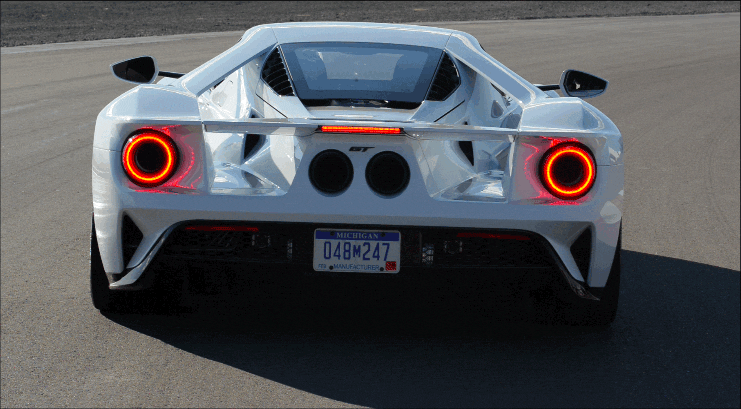The Wild Engineering That Gives the Ford GT Two Suspensions at Once

It should come as no surprise that the Ford GT has an active, adjustable, multi-mode suspension. Every current supercar, along with a growing number of more mundane machines, offers this capability in some form. But during our first ride-along in a preproduction prototype of the upcoming Ford supercar, we learned more about what's going on under the Blue Oval's halo car. And it's unlike anything you've ever seen before.
The GT's suspension system uses pushrod-actuated torsion bars in the place of traditional coil springs. This moves the major suspension components inboard, making room for the giant aero passages that are key to the car's keel-style flow-through aerodynamics.
Through a complex system that Ford only described to us in vague terms (as patents are still pending), each wheel is actually controlled by two springs acting in series. Think back to your physics courses: Stack two identical coil springs on top of each other, and you've created one giant spring that takes half the force to compress compared to the individual springs. In other words, your mega-spring has half the spring rate of the parts it's made of.
[contentlinks align="left" textonly="false" numbered="false" headline="More%20Ford%20GT?%20More%20Ford%20GT." customtitles="First%20Ride:%20The%20All-New%20Ford%20GT%7CExplaining%20the%20Ford%20GT's%20Five%20Drive%20Modes%7CAll-New%20Ford%20GT:%20Exclusive%20Images" customimages="||" content="article.31818|article.31820|gallery.6882"]
A system of torsion bars, rocker arms, and actuators controlled by the drive mode selector in the cabin creates such a system in the GT, with each wheel suspended by two springs acting in series. When the suspension is in Normal mode (corresponding to Normal or Wet drive mode), both springs are active, essentially "stacked." Dialing up Sport drive mode leaves the spring arrangement unchanged, but activates a firmer setting on the three-mode DSSV dampers.
When the driver selects Track or Vmax mode, the two-spring setup really shines. In either of these two hardcore settings, one of the springs is locked out, effectively doubling the spring rate acting on each wheel. The ride height drops by a massive 50mm (almost exactly two inches), reducing ground clearance to a mere 70mm (2.75 inches). The dampers go into the firmest of their three calibrations. In Track mode, the aero components go into full downforce mode; in Vmax, the wing and chassis splitters stay in their low-drag setting.

In effect, this Track/Vmax suspension setting is like having a completely unique chassis tuning. The ride height, spring rate and damping are all optimized for maximum performance, without compromising the comfort of Normal or Sport mode. You get a slammed-down racing suspension in a car that you can still drive on public roads to and from the track. There's even a "Comfort" button that further softens the dampers in Normal mode for particularly rough roads.
There's another nifty aspect to this setup: Since Ford runs the suspension and aero systems off the car's old-fashioned hydraulic power steering setup, the car switches from normal ride height to Track/Vmax mode quicker than any air suspension you've ever seen. There's also a nose-lift mode for attacking steep driveways without scraping-it picks the front of the car up so quickly, you'll think you're at a lowrider hopping competition.
We can't wait to try this nifty suspension setup out for ourselves.
You Might Also Like

 Yahoo Autos
Yahoo Autos 